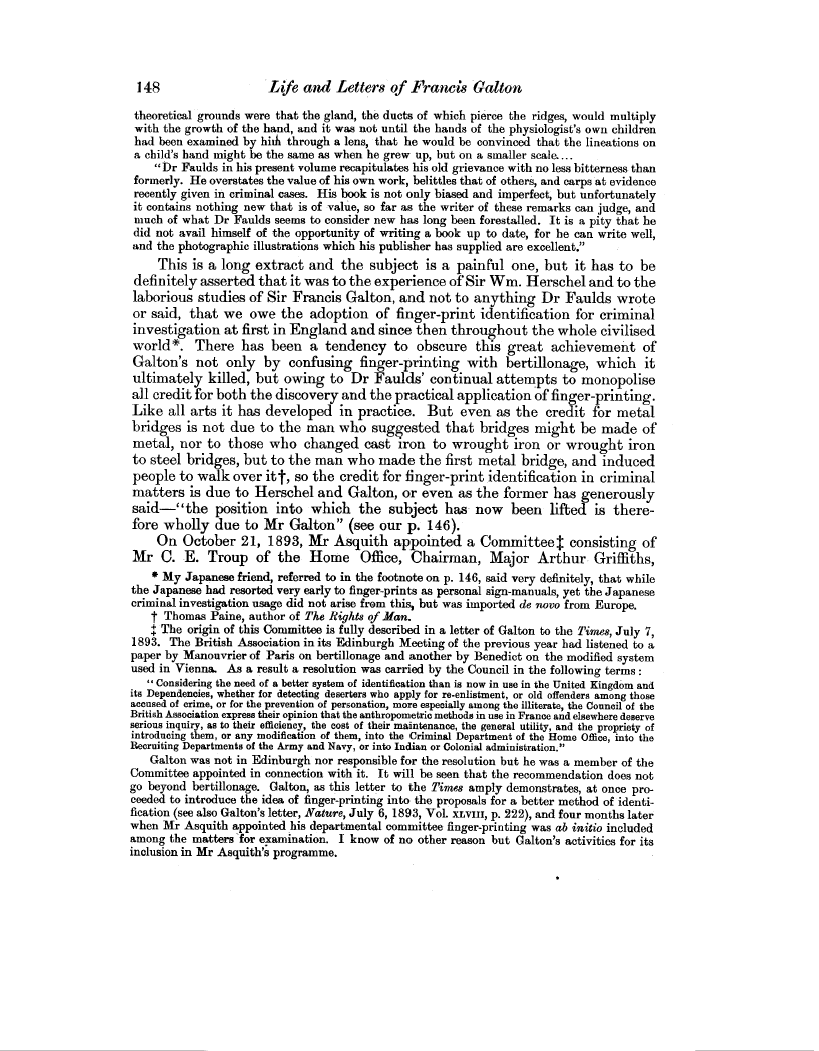| ||||||

OCR Rendition - approximate
148 Life and Letters of Francis Galton theoretical grounds were that the gland, the ducts of which pierce the ridges, would multiply with the growth of the hand, and it was not until the hands of the physiologist's own children had been examined by hirh through a lens, that he would be convinced that the lineations on a child's hand might be the same as when he grew up, but on a smaller scale.... '1 Dr Faulds in his present volume recapitulates his old grievance with no less bitterness than formerly. He overstates the value of his own work, belittles that of others, and carps at evidence recently given in criminal cases. His book is not only biased and imperfect, but unfortunately it contains nothing new that is of value, so far as the writer of these remarks can judge, and much of what Dr Faulds seems to consider new has long been forestalled. It is a pity that he did not avail himself of the opportunity of writing a book up to date, for he can write well, and the photographic illustrations which his publisher has supplied are excellent." This is a long extract and the subject is a painful one, but it has to be definitely asserted that it was to the experience of Sir Wm. Herschel and to the laborious studies of Sir Francis Galton, and not to anything Dr Faulds wrote or said, that we owe the adoption of finger-print identification for criminal investigation at first in England and since then throughout the whole civilised world*. There has been a tendency to obscure this great achievement of Galton's not only by confusing finger-printing with bertillonage, which it ultimately killed, but owing to Dr Faulds' continual attempts to monopolise all credit for both the discovery and the practical application of finger-printing. Like all arts it has developed in practice. But even as the credit for metal bridges is not due to the man who suggested that bridges might be made of metal, nor to those who changed cast iron to wrought iron or wrought iron to steel bridges, but to the man who made the first metal bridge, and induced people to walk over it j', so the credit for finger-print identification in criminal matters is due to Herschel and Galton, or even as the former has generously said-''the position into which the subject has- now been lifted is therefore wholly due to Mr Galton" (see our p. 146). On October 21, 1893, Mr Asquith appointed a Committee l consisting of Mr C. E. Troup of the Home Office, Chairman, Major Arthur- Griffiths, * My Japanese friend, referred to in the footnote on p. 146, said very definitely, that while the Japanese had resorted very early to finger-prints as personal sign-manuals, yet the Japanese criminal investigation usage did not arise from this, but was imported de novo from Europe. t Thomas Paine, author of The Rights of Man. + The origin of this Committee is fully described in a letter of Gallon o the Times, July 7, 1893. The British Association in its Edinburgh Meeting of the previous year bad listened to a paper by Manouvrier of Paris on bertillonage and another by Benedict on the modified system used in Vienna. As a result a resolution was carried by the Council in the following terms " Considering the need of a better system of identification than is now in use in the United Kingdom and its Dependencies, whether for detecting deserters who apply for re-enlistment, or old offenders among those accused of crime, or for the prevention of personation, more especially among the illiterate, the Council of the British Association express their opinion that the anthropometric methods in use in France and elsewhere deserve serious inquiry, as to their efficiency, the cost of their maintenance, the general utility, and the propriety of introducing them, or any modification of them, into the Criminal Department of the Home Office, into the Recruiting Departments of the Army and Navy, or into Indian or Colonial administration." Galton was not in Edinburgh nor responsible for the resolution but he was a member of the Committee appointed in connection with it. It will be seen that the recommendation does not go beyond bertillonage. Galton, as this letter to the Times amply demonstrates, at once proceeded to introduce the idea of finger-printing into the proposals for a better method of identification (see also Galton's letter, Nature, July 6, 1893, Vol. xLVUi, p. 222), and four months later when Mr Asquith appointed his departmental committee finger-printing was ab initio included among the matters `for examination. I know of no other reason but Galton's activities for its inclusion in Mr Asquith's programme.
|